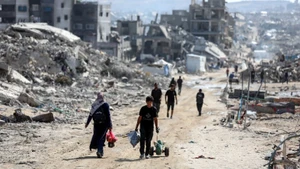Most migration routes from South America pass through the Darien jungle, the natural border between Colombia and Panama. The journey starts from the Gulf of Uraba, in northwestern Colombia, where a “security vacuum” exists due to the control of armed criminal groups. This has created an environment for weapons and drug smuggling, as well as human trafficking activities.
Migration through this dangerous jungle is not a new problem and has been on the rise since 2019. According to Panama’s official data, from the beginning of 2023 to December 20, 513,782 migrants crossed Darien, more than twice the number of 248,000 people in 2022.
Violence and poor socioeconomic conditions have pushed migrants to cross half a continent and venture into the treacherous jungle, considered the world’s most dangerous trail. Criminal gangs make millions of dollars through illegal migration. Some sources said that criminal groups charged migrants about 200 USD per person during the journey through the Darien forest.
This forest has become a “nightmare” for hundreds of migrants who cross here every day. They can become victims of wild animals, harsh weather, flash floods, sexual assault or robberies. On the first days of the new year 2024, Mexican authorities successfully rescued 31 migrants kidnapped by an armed group while they were on a bus to travel to Tamaulipas state, bordering the US.
Migrants making the dangerous journey from South America to the US in 2023 are mostly from Venezuela, Ecuador, and Haiti. Notably, about a quarter of the migrants are minors. The International Organisation for Migration’s (IOM) Missing Migrants Project has recorded 42 deaths or disappearances in Darien from the beginning of the year to December 2023, although the actual figures may be much higher.
Gender expert of the United Nations Children’s Fund (UNICEF) Johana Tejada López said that more than 100,000 children and adolescents have died in the jungle, with 50% being children under five years old. UNICEF experts warn about the trend of an increasing number of minors being separated from their parents during the migration journey and teenagers crossing the border alone.
The US, Colombia and Panama announced a joint agreement on resolving the migration issue, which affirmed that they will create new legal and flexible pathways for tens of thousands of migrants and refugees as a solution to the problem of illegal immigration.
Among these solutions are investment efforts to reduce poverty and create jobs in communities on the borders of Colombia and Panama. Mexico and the US also agreed to establish a joint committee dedicated to resolving the issue of migrants, including the task of improving the economic situation in countries in the region and regular dialogues with countries originating the migration flow.
The two North American countries agreed on the urgency of implementing additional measures to reopen important border crossings after the US closed border gates and bridges to prevent the flow of migrants.
The year 2023 reported a record number of migrants, with an estimated 100,000 to 105,000 people arriving at the border between Mexico and the US, and this number is expected to continue to rise this year. According to statistics from the Mexican Customs and Border Protection Agency, from January to November 2023, about 2.2 million migrants “transited” Mexico to find their way to the US. Many migrants have been lining up for months but have not yet been able to make an appointment according to the process to conduct procedures to enter the US. This makes the crisis worse. The US tried to stop the flow of migrants but was unsuccessful.
After suspending Title 42 in May, a controversial measure that allowed the immediate expel of undocumented migrants without the ability to claim asylum, President Joe Biden’s administration has implemented various measures to control the situation. Notably, it is the restriction of access to asylum, immediate deportation of illegal border crossers, and a foreign policy strategy to persuade other countries in the region, such as Colombia, Panama or Mexico, to act as “buffer zones” for migrants. However, the US is said not to have enough resources to detain large numbers of migrants pursuing the “American dream”.
Illegal immigration has become a top concern for American voters. Speaker of the House of Representatives Mike Johnson sent a letter to the White House calling on President Joe Biden to take executive action to stop illegal immigration at the southern border.
He asked the head of the White House to negotiate with Mexico to restore the programme that forces illegal immigrants to stay in Mexico. Discussions in the US Congress to tighten border policy have accelerated in recent weeks. Senate negotiators are also discussing changes to asylum and border regulations. Republicans see this issue as a condition for passing the Democrats’ proposal for a 110.5 billion USD foreign aid package.
In parallel with border measures, Washington has promoted “legal routes” to the US. According to data from the US Customs and Border Protection (CBP), more than 260,000 migrants have entered the US this year thanks to humanitarian permits. The US also coordinated with other countries and the United Nations High Commissioner for Refugees (UNHCR) to implement a “safe migration” initiative to direct migrants to the refugee programme. However, according to the latest data, less than 10% of the thousands of people who registered can participate in the programme.
Economic difficulties and political instability are the root causes of the problem of free migration. Therefore, countries in the region determine that, in addition to border control measures, they need to find a comprehensive solution to solve the problem of migrants from the roots.
















